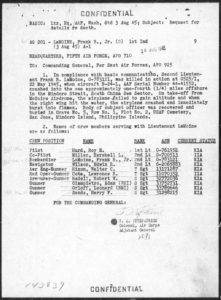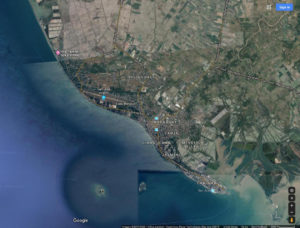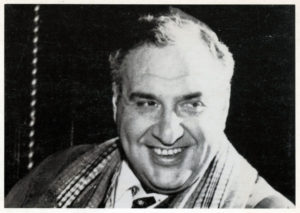Like The Jewish World of Britain, The Jewish Exponent during the early years of the First World War occasionally included works of fiction within its pages, some of which – inevitably, given the tenor of the times – pertained to military service of Jews soldiers in the armies of the Allied and Central Powers. The item below is one such example.
Appearing on the front page of the Exponent’s edition of August 27, 1915, this brief piece by Mabel Lyon (about whom I have no further information!) focuses on the experiences of a rabbi in the army of France. As presented by Lyon, the initial impetus for the rabbi’s military service is an ardent sense of patriotism inspired by the legacy and example of the Maccabees and Bar Kochba (at least, as imagined!) with the military genius and valor of Emperor Napoleon, Marshall Ney, and the Old Guard. However, the rabbi’s confrontation with the machine-like nature of war in the twentieth century soon dispels his ardor and idealism. This is replaced by a sense of grim resolution that is at first inspired through solidarity with his fellow Jewish soldiers, but then – sparked by the words of the hymn Adon Olam – this sense of idealism becomes universalized. Interestingly, however, the closing sentence of Lyon’s story returns to a focus on Jewish peoplehood.
You can read the full text of Lyon’s piece below, followed by three different interpretations of Adon Olam: From Wikipedia, Chabad, and the Ha Siddur Ha Shalem prayer book.
ADON OLMAN
A Rabbi at the Battle Front
By MABEL LYON
(Written for The Jewish Exponent)
The Jewish Exponent
August 27, 1915
“There are no less than twenty-five chief rabbis and rabbis attached to field ambulances at various points along the French line of defense. Since the outbreak of the war no rabbi has been allowed to leave the army for a single day’s furlough. The relationship between the rabbis and the Catholic priests is most friendly. At Verdun a joint service for fallen soldiers was held last December, at which the rabbi first read prayers in Hebrew, the Catholic in Latin, and the Protestant in French. Many of the rabbis have distinguished themselves by their heroism and by the important service they have rendered in the war.” – Jewish Exponent
“Teach me the Law during the time that I stand on one leg,” once said a heathen boy mockingly to Hillel.
“Thou shalt love they neighbor as thyself,” was the gentle reply. “This is the whole creed of Judaism, all the rest is commentary. Genesis, the holy writings and the prophets, all are contained in these simple hymns.”
________________________________________
Adon Olam was his favorite. It embodied all the others, he would say.
The war came and the young rabbi obeyed the call of his country to minister to the wounded and the dying of his people. The thrill that came to him as he said good-bye to his friends, to his congregation, and last of all to his nearest and dearest, was soon dissipated as he saw the battle field for the first time. He had pictured war as something sublime and all the fire of youth and the fighting spirit of the prophet, had been stirred to enthusiasm in anticipation of his work.
Often had the young French rabbi taken this story for his text, and he would draw an analogy between this and the all-embracing significance of the songs of Israel. “Let me teach you the creed of Israel in a word,” he would say, “and I will repeat for you the ‘Shema,’ the ‘En Kelohenu,’ ‘Yigdal’ or ‘Adon Olam.’
He had dreamed of the glorious wars of the Maccabees, fighting superbly against fearful odds; of the siege of Rome against Jerusalem and the unparalleled courage of its defenders, and to him the fruitless heroism of Bar Kochba, defying Rome a hundred years later, even in its utter failure, was sublime. The rabbi had often tried to picture the Napoleonic battles and to visualize the scenes suggested by Tschaikovsky’s 1812 Overture. He heard the Marseillaise, intermingling its stirring notes with the wild Russian hymns of battle; he saw the cuirassiers in their picturesque uniforms and his beloved tricoleur waving. And with it all sounded the tragically prophetic tones of the French retreat from Moscow. Napoleon’s campaign, too, had been a fight for selfishness and ambition, but at least it had the inspiration of one great dominating genius. The rabbi idolized Napoleon, forgetting his military crimes because of the statesman’s virtues and achievements. As a Frenchman the rabbi could understand the spirit of a Ney and the Old Guard, who were willing to follow their Emperor to exile or to death.
But here on the field of battle today what were men striving for? There was no Marseillaise to thrill and to inspire; no stirring national hymns were heard to instill new life into the wearied ranks of men.
There were no plumes of cuirassiers, no glittering corselets. No vari-colored uniforms to give life and brilliancy to the scene.
All was silent, save for the booming of cannon and the shrieks of shells. There was no temple to defend, no fight for liberty to give motive to this blind war. Machine-like men, blindly following leaders, asked vaguely, “Why?” But no answer came. They were machines operating machines against machines.
There was naught to mitigate the horrors which the young rabbi saw before him; nought of that which could inspire men with the frenzy of battle and make them forget pain and danger in its thrill.
The rabbi sickened; he felt faint; he longed to leave this scene of carnage and horror, but the pride of his race was stirring within him. He was not there to kill or maim; he was there to minister to those who needed him, and he must not turn away.
There were brothers of his faith near him; he knew them, he sat beside them. There was little time for words; there were so many there that looked to him for help.
“Shema Yisrael!” he cried alone. “Shema Yisrael!” repeated those who could follow his words.
But it was not alone men of his own faith that called to him. Protestants and Catholics, Mohammendans and even agnostics appealed to him for comfort.
He forgot the terror of the battle; he felt only the supreme emotion inspired by the presence of death; he asked not: “Are you Jew or Gentile, Mohammedan or agnostic?”
But “Shema Yisrael” was a prayer intended only for the Jew. Then came to his lips his favorite: “Adon Olam”. This would serve for all; for he knew no other credo. Adon Olam, a prayer for the dying; Alon Olam, a prayer of cheer for the living; Adom Olam, a prayer for the sorrowing.
“He is my God, my living God;
To Him I flee when tried in grief;
My banner high, my refuge strong,
Who hears and answers when I call.
My spirit I commit to him,
My body, too, and all I prize,
Both when I sleep and when I wake.
He is with me, I shall not fear.”
Often the young rabbi had asked himself: “What was it that had made Judaism survive through the ages?”
What was it but this very creed, simple and abiding, strong in faith but based on reason; universal, yet strengthening the sense of brotherhood between Jew and fellow Jew.
“The Lord of all did reign supreme
Ere yet this world was made and formed,
When all was finished by His will,
Then was His name as King proclaimed.
He still will rule in majesty;
He was, He is and shall remain
His glory never shall decrease.”
________________________________________
Three versions of Adon Olam…
Wikipedia
Eternal master, who reigned supreme,
Before all of creation was drawn.
When it was finished according to his will,
Then “King” his name was proclaimed to be.
When this our world shall be no more,
In majesty he still shall reign.
And he was, and he is,
And he will be in glory.
Alone is he, there is no second,
Without division or ally.
Without beginning, without end,
To him is the power and sovereignty.
He is my God, my living redeemer
Rock of my affliction in time of trouble.
He is my banner and refuge
Filling my cup the day I call.
Into his hand I commit my spirit
When I sleep, and I awake.
And with my spirit, my body
The Lord is with me, I will not fear.
Chabad (Avraham Friedman)
Lord of the universe, who reigned
before everything as created,
at the time when by His will all things were made,
then was His name proclaimed King,
and after all things shall cease to be,
the Awesome One Will reign alone.
He was, he is and
He shall be in glory.
He is One and there is no other
to compare to Him, to consort with Him.
Without beginning without end,
power and dominion belong to Him.
He is My G‑d and my ever-living redeemer.
The strength of my lot in time of distress.
He is my banner and my refuge,
my portion on the day I call.
Into His band I entrust my spirit,
when I sleep and when I awake.
With my soul, my body too,
the L-rd is with me, I shall not fear.
Ha-Siddur Ha-Shalem (Hebrew Publishing Company – 1949)
He is the eternal Lord who reigned
Before any being was created.
At the time when all was made by His will,
He was at once acknowledged as King.
At the end, when all shall cease to be,
The revered God alone shall still be King.
He was, He is, and He shall be
In glorious eternity.
He is one, and there is no other
To compare to Him, to place beside Him.
He is without beginning, without end;
Power and dominion belong to Him.
He is my God, my living Redeemer,
My stronghold in times of distress.
He is my guide and my refuge,
My share of bliss when I call.
To Him I entrust my spirit
When I sleep and when I wake
As long as my soul is with my body
The Lord is with me; I am not afraid.
References
Adon Olam, Interpretation / Arrangement by Avraham Friedman, at Chabad.org
Adon Olam, at Wikipedia
Daily Prayer Book – Ha-Siddur Ha-Shalem, Translated and Annotated with an Introduction by Philip Birnbaum, Hebrew Publishing Company, New York, N.Y., 1949
Ha-Siddur Ha-Shalem, at Open Prayer Book




















